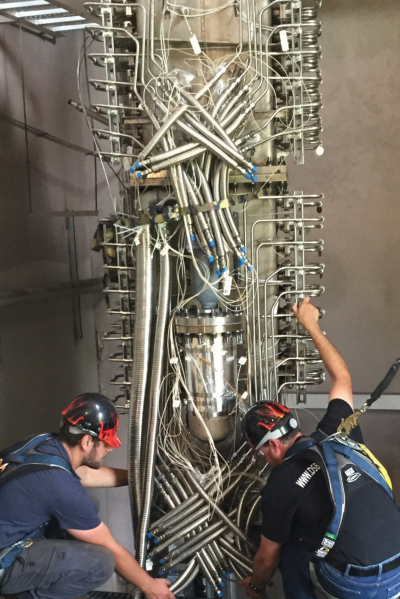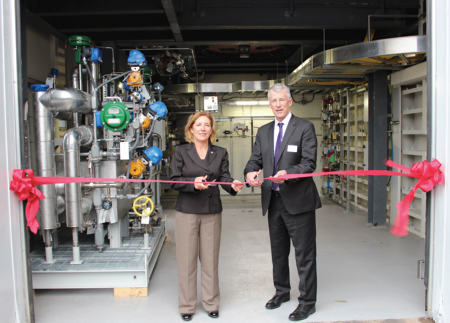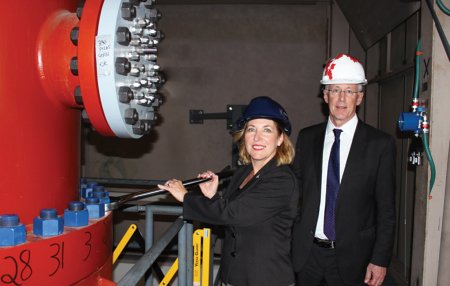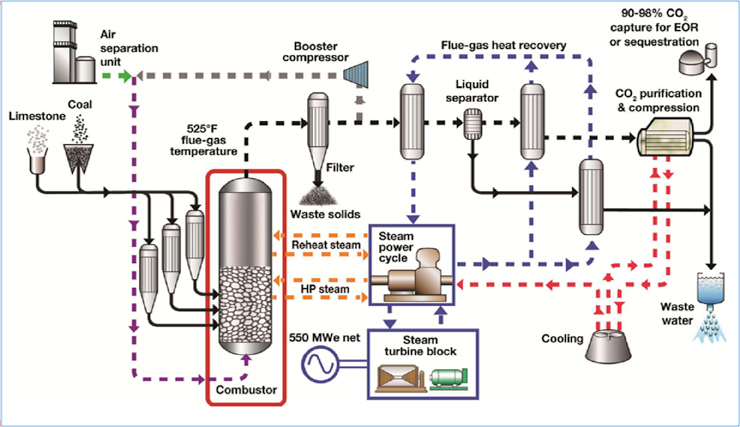As renewable energy grows as a serious option for delivering capacity for power generation, fossil fuels continue to serve as the top source for energy production worldwide.
It’s a dilemma. Fossil fuels are the world’s most abundant and lowest-cost fuel source, so countries across the globe need to continue to burn fossil fuels to produce affordable electricity. Yet, because it relies heavily on coal, the most carbon-intensive fossil fuel, power generation is one of the primary sources of carbon dioxide (CO2) emission, with electricity and heat generation accounting for nearly half (42 percent) of global CO2 emissions in 2013.1
A solution is needed that can significantly reduce the impact of CO2 and other greenhouse gas (GHG) emissions on climate change. For years, climate researchers have focused on technology solutions designed to achieve large-scale reductions of carbon emissions from fossil-fueled power plants.
When fossil fuels are burned with air, the exhaust gases (primarily nitrogen from the air, CO2 and water vapor) are emitted into the atmosphere, typically through a chimney, or flue. Carbon capture and storage (CCS) technologies, which are designed to separate CO2 from the flue gas so that it can be prepared and pressurized for underground storage, or sequestration, are recognized as the most practical method for controlling the by-products of fossil-fueled power plants. The International Energy Agency (IEA) projects that, by 2050, CCS will account for 13 percent of global emissions reductions.2
A Range of Approaches to CCS
The recent Paris Climate Conference (COP21) ramped up momentum for research and development (R&D) to advance CCS technologies. The Paris climate-change agreement that resulted from the conference represented a commitment by 195 countries to work to reduce GHG emissions to a level that will keep global temperatures from rising more than 2° C by 2100. The agreement also includes a provision that requires developed countries to significantly increase their clean energy R&D funding over the next five years.
Over the years, researchers have developed a range of approaches to separating CO2 from the flue gas mixture that is a by-product of power generation. Current technology employs the post-combustion approach to reducing carbon emissions at existing power plants. In this process, flue gases pass through a process in which the CO2 is separated and stored.

Oxy-PFBC Combustor
With pre-combustion capture, or integrated gasification combined cycle (IGCC), oxygen is stripped from the atmosphere to produce a nearly pure stream of oxygen gas, which is fed into a gasifier that bakes the coal and releases syngas, a mixture of gases (hydrogen, carbon monoxide, and CO2). The syngas is subsequently separated into CO2 and hydrogen. The hydrogen is then combusted in a gas turbine to generate electricity, while the CO2 is compressed for storage.
The capture and storage of CO2 using these methods requires a significant amount of energy and cost. A recent report from the U.S. Department of Energy (DOE) projected that implementation of CCS technologies like post-combustion and IGCC will increase electricity costs by more than 75 percent, compared with coal power plants without CCS4--an increase in cost that is often referred to as the ‘carbon capture penalty.’ For carbon capture to be affordable, these high costs—and the high energy penalties associated with them—must be reduced.
Pressurized Oxy-Combustion: Moving the Carbon Capture Needle
The National Energy Technology Laboratory (NETL) of the DOE, in its efforts to support the national objectives of addressing climate change by reducing GHGs, is funding projects through its Advanced Combustion Systems Program to demonstrate two new carbon capture technologies—chemical looping combustion and pressurized oxy-combustion. With these technologies, NETL hopes to meet the cost and complexity challenges of carbon capture.
Pressurized oxy-combustion promises to significantly shrink the carbon capture penalty paid by pre-combustion and post-combustion processes by burning fuel using a pressurized mixture of oxygen and CO2 instead of air. The nitrogen is removed from the air prior to combustion. This improves efficiency and results in flue gas that is primarily CO2 and water vapor, enabling simpler and lower-cost CO2 separation. Pressurization also drives down the size of the equipment, resulting in additional cost savings.
“When fuel is combusted with conventional technology, the exhaust gases are unpressurized and consist mostly of nitrogen, so it’s difficult to separate out the constituents,” says Don Stevenson, executive director at Gas Technology Institute (GTI), a leading energy and environmental R&D organization that is spearheading the effort to advance the oxy-fired pressurized fluidized bed combustor (Oxy-PFBC), a new oxy-combustion technology.
The GTI Oxy-PFBC plant was recently launched with a ribbon-cutting ceremony for the pilot test facility at CanmetENERGY in Ottawa, Canada. The Oxy-PFBC process introduces an additional element to the pressurized oxycombustion process. “The technology uses a technique called a fluidized bed,” says Stevenson. “It’s the enabling technology that allows us to maximize the heat transfer and to package the technology into a single pressure vessel.” This is a unique solution. “Other people are looking at pressurized oxy-combustion, but they are not using the fluidized bed.”

Ribbon Cutting Kim Rudd and Douglas Hollett
“The combustor was designed by a team of ex-rocket scientists to achieve record-breaking power density,” adds Bill Follett, GTI’s program manager for the Oxy-PFBC project. “We use oxy-combustion for rapid burning and heat release, but need to remove the heat as rapidly as we create it. The fluidized bed is composed of loosely packed sand-like particles in constant motion. As they hit the steam tubes inside the combustor, they are three times more effective than gas in transferring heat out. It all comes together in a low-cost, compact, integrated package.”
The demonstration in Canada will validate performance and plant economics using NETL guidelines. It will also identify technology gaps that need to be filled to advance the technology.
Game-Changing Benefits
The Oxy-PFBC process offers a number of benefits, one of the most important being the reduction in the cost of carbon capture, which has long been one of the key challenges to U.S. efforts to scale technologies to the levels that are needed to slow global warming. Oxy-combustion enables high-efficiency gas cleanup, while pressurization shrinks the equipment size and the cost. The combustor is one-third the size of a traditional combustor and less than half the cost, saving hundreds of millions of dollars for a commercial-scale plant.
These reductions in equipment costs are reflected in a lower cost of electricity. Compared with pre- and post-combustion technologies, the cost of electricity is reduced by 23 to 30 percent, eliminating up to three-fourths of the carbon capture penalty associated with these technologies. Sale of the purified CO2 can reduce the penalty even further, possibly eliminating it altogether.
Even more important, pressurized fluidized bed combustion can result in electricity production from coal with near-zero emissions, while biomass-coal blends can achieve negative CO2 emissions. A commercial-scale plant can capture CO2 emissions equivalent to removing 145,000 cars from the road.
The DOE has high hopes for the Oxy-PFBC process. A recent NETL press release stated that “this project is a major step forward for CCUS,” adding that “the captured CO2 can then be stored or used beneficially to develop other products, including feedstock and chemicals.”5
A Powerful Partnership
The Oxy-PFBC demonstration project is a joint effort between the U.S. DOE and its Canadian counterpart, Natural Resources Canada (NRCan). Research is being spearheaded by GTI in collaboration with CanmetENERGY, Linde, Electric Power Research Institute (EPRI), GE, Pennsylvania State University, and University of Ottawa – with support from the NETL, the Canadian Clean Power Coalition, and Alberta Innovates.

At the ribbon cutting event, Kim Rudd of NRCan (with wrench) and Douglas Hollett of the US DOE
conduct a ceremonial bolt tightening on the Oxy-PFBC to celebrate construction of the pilot scale plant
and the U.S. / Canada collaboration to meet international climate change objectives.
GTI designed the system, fabricated the Oxy-PFBC, and did the system modeling. The Ottawa test facility is hosted by CanmetENERGY, which is the R&D laboratory for NRCan. “Canmet has unique facilities to accommodate the system setup, and the researchers there have valuable knowledge in this area,” says Stevenson. “They are familiar with the challenges and are a great resource for helping us work through the integration issues.” Linde designed and built the CO2 capture and cleanup equipment.
The project is an example of the ongoing cooperation between the U.S. and Canada that has driven efforts to generate electricity and heat with zero emissions. “Canada and the United States share a bold vision for our continent,” said Kim Rudd, parliamentary secretary to the Minister of NRCan. “We will continue to work together to meet our climate change objectives, increase competitiveness, and support employment opportunities.”
The U.S. and Canada, in fact, worked together at COP21 last December to launch Mission Innovation, a 20-country commitment to double each country’s respective investments in clean energy R&D over the next five years. “[The Oxy-PFBC project] highlights the importance of the long-standing U.S.-Canadian collaboration on clean energy technology development,” said Douglas Hollett, principal deputy assistant for fossil energy at DOE.
This December, the team will begin to validate the process and conduct extensive testing on various feedstocks with the pilot plant to mature the technology. This will serve to close technology gaps to advance progress toward the DOE carbon capture goal of demonstrating technologies and best practices that can achieve more than 90 percent carbon capture and reduce electricity costs by at least 20 percent relative to current carbon capture technology.
The project received $13 million from the DOE Office of Fossil Energy’s advanced combustion program and is managed by NETL.
In addition to the Oxy-PFBC project, GTI is designing, fabricating, and testing a supercritical CO2 (SCO2) power-cycle heat exchanger designed to enable the pilot plant to achieve even greater power-cycle efficiencies and lower costs. A steam cycle will reduce the cost of electricity by 23 percent, while an SCO2 cycle can deliver a 30-percent reduction.
“The conventional approach to power generation uses heat to convert water to steam, which is then used to run a steam turbine,” says Follett. “Using supercritical CO2 instead of steam offers a more efficient method of generating electricity. While supercritical CO2 is used in a similar manner to steam in a power cycle, it has interesting properties that provide several advantages for lower-cost electricity generation.”
Supercritical CO2 is a form of CO2 at high temperature and pressure. While it is neither a liquid nor a gas, it has some properties of both. The advantages of using supercritical CO2 in a power cycle are:
- Its high density drastically reduces the size of turbines for lower cost.
- Its critical pressure is one third of steam, which permits lower operating pressure.
- Unlike steam, it can be pumped like a liquid for higher efficiency without the need for a condenser.
As a result, when the Oxy-PFBC process is coupled with supercritical CO2, reductions in the overall cost of electricity production with carbon capture can be even greater.
Looking to the Future
Successful results from the Oxy-PFBC project will serve to jump-start efforts to bring it to commercial scale. According to Stevenson, there are two potential applications for the process: a retrofit and a brand-new plant. “In a retrofit scenario, we could take this system and apply it to an existing power plant by adding air-separation units to produce oxygen, replacing the boiler, and providing steam to the existing power cycle. In this case, there would be no need to replace the turbine.”
In the future, fully proven and commercialized supercritical CO2 will enable the construction of brand-new power plants with a smaller footprint. GTI is currently working with General Electric Global Research and other partners to design, build, and operate a DOE-funded supercritical CO2 pilot plant test facility in Texas.
Projects like the Oxy-PFBC demonstration offer great promise for nations looking to continue to rely on fossil fuel-based power generation, while also helping them minimize climate change. “As we look ahead, the real potential for this technology is for global application, particularly in the developing world, where countries are heavily dependent on coal,” says Stevenson.
The Oxy-PFBC process
Coal is injected and burned with a mixture of oxygen and CO2 in the fluidized bed (Combustor). Limestone is also injected to capture sulfur. As the coal is combusted inside the pressure vessel, the water moves through the tubes arrayed inside the combustor and the fluidized bed enhances heat transfer to the tubes to turn the water into steam. Steam moves into the turbine to generate electricity Pressurized CO2 and water exit as flue gas. The water is removed and the CO2 purification system removes other trace gases. The purified CO2 is pressurized further and piped out for sequestration (as shown in the top right corner of the figure.)
“As restrictions from COP21 and subsequent efforts to curb CO2 become stricter, this will be one of the technologies that many countries will have to turn to, because it provides an affordable way to produce power with full carbon capture.”
About the Authors
 Don Stevenson, Executive Director, Research & Development, leads GTI’s Advanced Energy Systems Group that was formed in July 2015 from the acquisition of the terrestrial energy technology portfolio from Aerojet Rocketdyne. His team is responsible for the development and commercialization of advanced combustion and energy conversion technologies for chemicals and power production, as well as emission mitigation, water treatment, and oil recovery.
Don Stevenson, Executive Director, Research & Development, leads GTI’s Advanced Energy Systems Group that was formed in July 2015 from the acquisition of the terrestrial energy technology portfolio from Aerojet Rocketdyne. His team is responsible for the development and commercialization of advanced combustion and energy conversion technologies for chemicals and power production, as well as emission mitigation, water treatment, and oil recovery.
Don earned a B.S. in Aeronautic & Astronautics from University of Washington and an M.B.A. from Pepperdine University, completed courses toward an Advanced Project Management Certificate Program from Stanford University and participated in the Executive Management Program at University of Virginia Darden School.
 William Follett IV is a Program Manager of Fossil Fuel Energy Systems at GTI. He has 29 years of experience in technology development across a broad array of technologies that span the energy, space, underwater, and automotive application areas. Energy applications include coal combustion, supercritical CO2 cycle, and fuel cells. Coming to GTI from Aerojet Rocketdyne, he is responsible for execution and program capture activities that are step-change or transformative technologies in the energy industry.
William Follett IV is a Program Manager of Fossil Fuel Energy Systems at GTI. He has 29 years of experience in technology development across a broad array of technologies that span the energy, space, underwater, and automotive application areas. Energy applications include coal combustion, supercritical CO2 cycle, and fuel cells. Coming to GTI from Aerojet Rocketdyne, he is responsible for execution and program capture activities that are step-change or transformative technologies in the energy industry.
Mr. Follett earned an M.S. in Mechanical Engineering from Stanford University, and a B.S. in Mechanical Engineering from Texas A&M University.
1 International Energy Agency, “IEA Statistics: CO2 Emissions from fuel Combustion, 2015 edition,” p. 10. Find at: https://www.iea.org/publications/freepublications/publication/CO2EmissionsFromFuelCombustionHighlights2015.pdf
2 World Resources in Institute, “Carbon capture and storage: Prospects after Paris.” Find at: http://www.wri.org/blog/2016/04/carbon-capture-and-storage-prospects-after-paris.COP
3 U.S. DOE/NETL, “Cost and Performance of PC and IGCC Plants for a Range of Carbon Dioxide Capture, Revision 1,” (2013).
4 NETL, “DOE, Natural Resources Canada announce pilot plant to advance oxy-combustion
carbon capture,” Oct. 19, 2016. Find at: https://netl.doe.gov/newsroom/news-releases/newsdetails?id=ba007d89-047b-49ad-b3c8-416f92027150
5 http://www.gastechnology.org/news/Pages/GTI-Selected-to-Lead-a-Supercritical-CO2-Project.aspx










